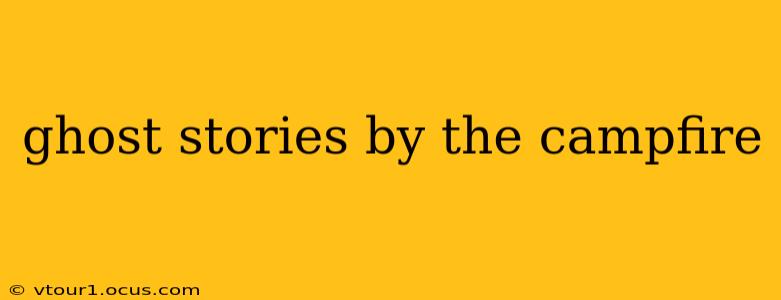The crackling campfire, the inky blackness of the night, the hushed whispers of friends – the perfect setting for a chilling ghost story. Telling a good ghost story around a campfire is an art form, a blend of suspense, atmosphere, and a touch of theatrical flair. But crafting a truly memorable tale requires more than just a spooky premise; it demands skillful storytelling techniques to truly captivate your audience. This guide dives into the essentials, helping you perfect your campfire ghost story repertoire.
What Makes a Great Campfire Ghost Story?
A truly effective campfire ghost story isn't just about jump scares; it's about building tension and playing on primal fears. Here are some key ingredients:
- Setting the Scene: The environment is crucial. Vividly describe the location – a creepy old house, a desolate graveyard, a fog-shrouded forest. Use evocative language to paint a picture in the listeners' minds.
- Building Suspense: Don't reveal everything at once. Gradually introduce unsettling details, leaving the audience to fill in the blanks with their own imaginations. The power of suggestion is far more potent than explicit descriptions.
- Unreliable Narrator: Consider using an unreliable narrator—someone whose perspective is flawed or who might be withholding information. This adds a layer of mystery and keeps the audience guessing.
- The Power of Sound: Incorporate sounds into your narrative – the creak of a door, the rustling of leaves, a distant whisper. These auditory details heighten the sense of unease.
- A Satisfying (or Unsatisfying) Ending: The ending is crucial. A truly chilling story might leave the audience with unanswered questions, a lingering sense of dread, or a perfectly ambiguous conclusion that allows each listener to create their own interpretation.
How to Structure Your Campfire Ghost Story
A well-structured story keeps listeners engaged. Here's a suggested approach:
- The Hook: Begin with a compelling opening line or scene that immediately grabs attention. Think of it as the bait on your hook.
- Rising Action: Gradually build suspense by introducing unsettling details, hinting at the supernatural, and creating a sense of foreboding.
- Climax: The point of maximum tension, where the ghost or supernatural element is revealed (or perhaps hinted at but not fully shown).
- Falling Action: The aftermath of the climax; the resolution or lack thereof.
- Resolution (or Lack Thereof): Do you offer a clear resolution, leaving the audience with a sense of closure or a lingering feeling of unease? Consider what will stick with the listener long after your story is finished.
What are some popular types of ghost stories?
Many subgenres fall under the ghost story umbrella, offering diverse possibilities for your campfire tale.
- Haunted House Stories: These classics utilize the familiar setting of a creepy, abandoned house to build suspense and fear. Think creaking floors, shadowy figures, and objects moving on their own.
- Urban Legends: These stories, often passed down through generations, often play on real-world anxieties and fears. They tap into a sense of shared experience and can be particularly effective in a group setting.
- Ghostly Encounters: These stories focus on direct interactions between the living and the dead, often featuring apparitions, voices from the beyond, or inexplicable occurrences.
- Psychological Horror: This less literal approach plays with the characters' minds and perceptions, leaving the audience questioning what is real and what is imagined.
What are some tips for telling a good campfire ghost story?
- Practice your delivery: Telling a story well involves more than just reading the words on a page. Practice your pacing, tone, and vocal inflections to maximize the impact.
- Use descriptive language: Paint a vivid picture for your audience with vivid descriptions. Engage all their senses.
- Use pauses effectively: A strategic pause can build anticipation and suspense, making your story more chilling.
- Adjust your story to your audience: Consider the age and sensitivities of your listeners when choosing a story and how you tell it.
- Incorporate audience participation: Encourage interaction by asking questions or inviting suggestions from your audience to involve them in the narrative.
By mastering these techniques and embracing your creativity, you can transform a simple campfire gathering into an unforgettable night of spooky storytelling. So gather around, let the fire crackle, and let the chilling tales begin!
